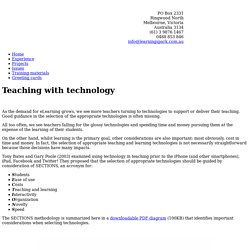

Recherche : pédagogie et numérique. Outils numériques pour une approche hybride de l'enseignement. Expériences sur le terrain. Préparer le terrain. Classe inversée / Flipped classroom. 10 Drivers Of Blended Learning In Education. Blended learning is the use of both face-to-face and eLearning approaches to deliver learning experiences (as opposed to direct instruction).
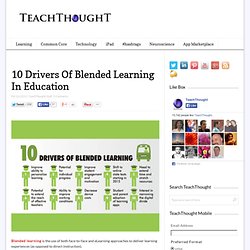
Whether you’re mixing a formal learning management system with in-person lectures, or a flipped approach that combines YouTube videos with in-class group work and individual instruction, these are all examples of blended learning. The infographic below from the good folks at Digital Learning Now offers a basic framework for implementing blended learning (Create conditions for success, Plan, Implement, Improve), and then interestingly offers to “drivers” of blended learning, including online state testing, cost, and the critical ability to personalize learning. 30gestion. Popplet. Active Learning. How to create an active classroom experience with technology.

GUEST COLUMN | by Jessica Sanders The traditional teaching method of giving a lesson at the front of the class puts you, the teacher, in an active position but leaves students in a passive role, where they are taught to but don’t interact with the material as much they should. In fact, Edudemic reported that teachers do 80 percent of the talking in class. This format can quickly cause students to become bored and disengaged—students that aren’t engaged have a higher rate of failing. When you use technology, however, the classroom becomes an active space, where you can interact with students and be more hands on. Creating an active learning environment is also a valuable opportunity for teachers of younger students, who have keep a whole class of inattentive students focused and interested.
Classroom Design (The Non-Tech Portion) Step 1: Assess Student Objectives Or you can use the following ideas to build entirely new lessons: 16 of the Best Blended Learning Resources. In February 2014, Edreform.com published a paper on digital and blended learning that points out over “68 percent of parents support digital learning” and “digital learning has tri-partisan support, with 61 percent of Republicans, 65 percent of Independents, and 67 percent of Democrats in favor.”
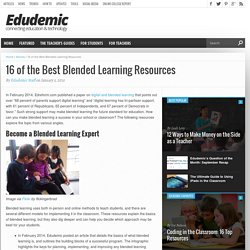
Such strong support may make blended learning the future standard for education. How can you make blended learning a success in your school or classroom? The following resources explore the topic from various angles. Become a Blended Learning Expert Image via Flickr by flickingerbrad Blended learning uses both in-person and online methods to teach students, and there are several different models for implementing it in the classroom. In February 2014, Edudemic posted an article that details the basics of what blended learning is, and outlines the building blocks of a successful program. Biblio_FH.pdf. Popplet. What Everybody Ought to Know About Instructional Design. In an earlier post, we looked at how to build better courses by trimming out some of the content.

Many of the follow-up comments and questions speak to your role as an instructional designer. In fact, it’s a question I was asked in a recent email: What is the role of the instructional designer? And how do I convey that to my clients and subject matter experts? As I was contemplating a response, I stumbled upon this video that does a great job illustrating the value of instructional design. Too Sexy for Your Training: Creating A “What’s In it for Me?” (WIIFM) When Your Learners Couldn’t Care Less.
Two integral parts of any large change within an organization are gaining buy-in for the change and developing internal change champions.
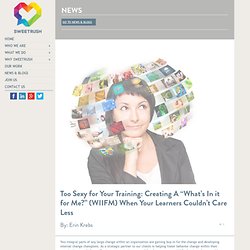
As a strategic partner to our clients in helping foster behavior change within their organizations, we believe effective communications around the change are essential for buy-in and success. We can make the best training in the world, but if learners aren’t “buying in” at an organizational level, training can be deemed ineffective when, in reality, it has nothing to do with the quality of the training, but rather other organizational currents. To help our clients address and overcome these challenges, we often weave in communication campaigns with our training deliverables. This helps learners understand the why and WIIFM behind the new process or procedure on which we’re training them. The Open Classroom. Like automotive models, women’s hemlines, and children’s toys, pedagogical fads come and go, causing an immediate stir but rarely influencing teaching practice in any significant way.
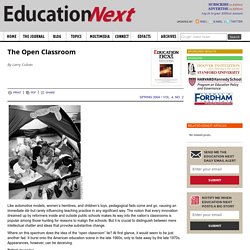
The notion that every innovation dreamed up by reformers inside and outside public schools makes its way into the nation’s classrooms is popular among those hunting for reasons to malign the schools. But it is crucial to distinguish between mere intellectual chatter and ideas that provoke substantive change. Where on this spectrum does the idea of the “open classroom” lie? At first glance, it would seem to be just another fad. It burst onto the American education scene in the late 1960s, only to fade away by the late 1970s. British Invasion The open-classroom movement originated in British public elementary schools after World War II. For more than a decade, U.S. schools had been subjected to withering attacks, blamed for everything from the launch of Sputnik to urban decay. Schools without Walls. UDL Guidelines 2.0.
The goal of education in the 21st century is not simply the mastery of content knowledge or use of new technologies.
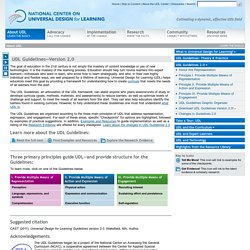
It is the mastery of the learning process. Education should help turn novice learners into expert learners—individuals who want to learn, who know how to learn strategically, and who, in their own highly individual and flexible ways, are well prepared for a lifetime of learning. Universal Design for Learning (UDL) helps educators meet this goal by providing a framework for understanding how to create curricula that meets the needs of all learners from the start. UDL At A Glance. Kevin's Applying SECTIONS 3.isf - SECTIONSKevin3.pdf. Select teaching technology with SECTIONS. As the demand for eLearning grows, we see more teachers turning to technologies to support or deliver their teaching.
